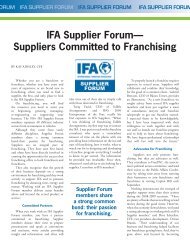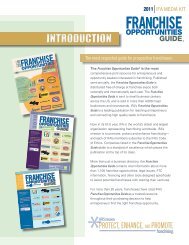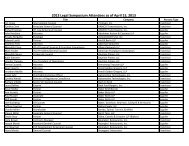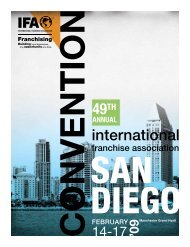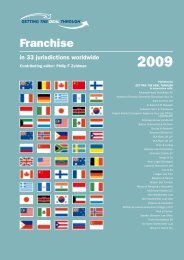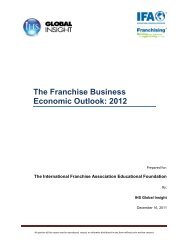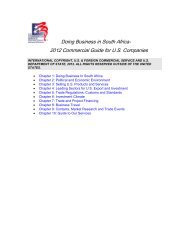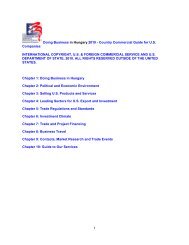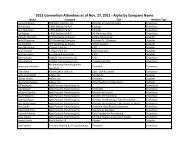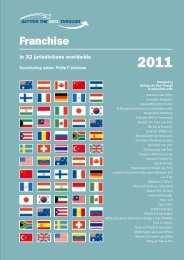Doing Business in Saudi Arabia - International Franchise Association
Doing Business in Saudi Arabia - International Franchise Association
Doing Business in Saudi Arabia - International Franchise Association
Create successful ePaper yourself
Turn your PDF publications into a flip-book with our unique Google optimized e-Paper software.
educe its soybean import subsidy from $396 per metric ton <strong>in</strong> March 2008 to $101 <strong>in</strong> January<br />
2009. The rebate is paid directly to importers. Currently, <strong>Saudi</strong> <strong>Arabia</strong> imports about 800,000<br />
metric tons of soybean meal per year.<br />
Year/Description 2007 2008 2009<br />
Total Consumption 520 480 400<br />
Total Local Production 0 0 0<br />
Total Exports 0 0 0<br />
Total Imports 520 480 400<br />
Imports from the U.S. 50 84 55<br />
Source: Trade estimates and U.S. Customs official data<br />
Value: In millions of U.S. dollars<br />
RICE (0422110) Return to top<br />
Overview<br />
<strong>Saudi</strong> <strong>Arabia</strong> imports more than one million metric tons of rice annually. With 60 percent market<br />
share, Indian rema<strong>in</strong>ed the dom<strong>in</strong>ant rice supplier to <strong>Saudi</strong> <strong>Arabia</strong>, followed by Pakistan, United<br />
States and Thailand. In 2008, the value of the United States rice exports to <strong>Saudi</strong> <strong>Arabia</strong><br />
reached $117 million, an <strong>in</strong>crease of 47 percent compared to 2007. Accord<strong>in</strong>g to a recent U.S.<br />
Customs data, U.S. rice exports to <strong>Saudi</strong> <strong>Arabia</strong> <strong>in</strong>creased by 10 percent <strong>in</strong> January-October<br />
2009 compared to the same period last year ($109 million vs. $99 million). Local rice importers<br />
attribute the sharp <strong>in</strong>crease <strong>in</strong> U.S. exports <strong>in</strong> recent years to a decrease <strong>in</strong> exportable rice from<br />
India and U.S. price competitiveness compared to other Asian rice exporters. The higher values<br />
of total rice imports <strong>in</strong> 2007 and 2008 reflect the sharp <strong>in</strong>crease <strong>in</strong> the world prices for rice<br />
dur<strong>in</strong>g that period. In November 2009, the <strong>Saudi</strong> government removed the $267 per metric ton<br />
subsidy on imported rice which it decreed <strong>in</strong> December 2007. The <strong>Saudi</strong> government lifted the<br />
import subsidy due to reduced world rice prices compared to 2007 and early 2008.<br />
Year/Description 2007 2008 2009<br />
Total Consumption 750 700 620<br />
Total Local Production 0 0 0<br />
Total Exports 0 0 0<br />
Total Imports 800 670 800<br />
Imports from the U.S. 80 117 130<br />
Source: Trade estimates and U.S. Customs official data<br />
Value: In millions of U.S. dollars<br />
PROCESSED FRUITS AND VEGETABLES Return to top<br />
Overview<br />
The <strong>Saudi</strong> market for processed fruits and vegetables is huge. The growth of supermarket and<br />
hypermarket food sales is help<strong>in</strong>g to broaden the market for this sector and good market growth<br />
is expected to cont<strong>in</strong>ue <strong>in</strong> the next few years as supermarkets and hypermarkets open more<br />
outlets <strong>in</strong> major cities of the K<strong>in</strong>gdom. Local production of canned fruit and vegetables has<br />
been <strong>in</strong>creas<strong>in</strong>g <strong>in</strong> recent years but it depends almost entirely on imported <strong>in</strong>gredients, some of<br />
which are sourced from the United States. The majority of the processed fruit and vegetables





